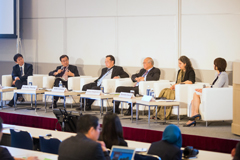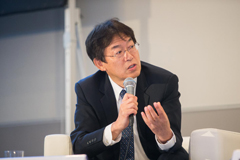Chief Economist Hirota Discusses Bridging the Infrastructure Gap in Asia
2017.05.30
The Japan International Cooperation Agency (JICA) and the Asian Development Bank (ADB) co-hosted a seminar titled “Bridging the Infrastructure Gap in Asia” on May 5, 2017, in Yokohama on the occasion of the 50th Annual Meeting of the ADB.
In the beginning, Juzhong Zhuang, Deputy Chief Economist at ADB, and Koki Hirota, Chief Economist at JICA, gave keynote presentations on their researches on Asian infrastructure demand estimates. This was followed by a panel discussion moderated by Yumiko Noda, Partner of PwC Japan and former Deputy Mayor of Yokohama City, with panelists from India, Indonesia, and Thailand. The panel discussed how policymakers can better manage, design, and implement policies to bridge their infrastructure gaps.

Panelists discussed how to bridge the infrastructure gap in Asia
In the keynote, Zhuang presented the findings from ADB’s new report, “Meeting Asia’s Infrastructure Needs,” released in February 2017. The developing Asia and the Pacific will need to invest around $1.7 trillion per year from 2016 to 2030 ($26 trillion in total) in economic infrastructure to maintain growth momentum and respond to climate change. Annual investment demand for 2016–2030 is more than double that for 2010–2020, which indicates that infrastructure demand in Asia is growing rapidly. Zhuang pointed out that the infrastructure investment gap will be 2.4% of the projected GDP from 2016 to 2020, which will rise to 5% if figures for China are excluded.
Hirota introduced the preliminary findings from JICA’s research on the demand estimate for social and disaster prevention infrastructure in Asia. Although the research is still only halfway through analysis, results from model country studies indicate for the first time that there is substantial demand for social infrastructure in addition to economic infrastructure. Model country case studies suggest that Japan’s experiences could be useful in analyzing growing demands in Asia. Hirota noted the fact that Japan revising its school facility criteria in the course of its economic development may serve as a reference for other Asian countries to foresee such growth.

Koki Hirota, Chief Economist at JICA
Regarding disaster prevention infrastructure, Hirota noted that there is a tendency for budget allocation to increase only after major disasters and mentioned that the key consideration is how to establish the ecosystem to mainstream such investment within development planning and the budgetary process.
During the panel discussion, Sharmila Chavaly, Joint Secretary of the Infrastructure and Energy Division at the Ministry of Finance, India; Kuntoro Mangkusubroto, professor at the Bandung Institute of Technology, Indonesia; and Kitti Limskul, professor at Saitama University and former Vice Minister of Finance, Thailand, presented their views on measures to fill infrastructure investment gaps and challenges around infrastructure development. Chavaly shared India’s innovative financing experiences such as PPP, infrastructure debt funds, and municipal bonds, which were identified as advanced examples to fill the gap. Mangkusubroto shared lessons from Aceh’s experiences after the 2004 Asian tsunami, which indicated that flexibility in the decision-making process is key to quick recovery and reiterated the importance of mainstreaming disaster prevention investment. Limskul pointed out the importance of investing in social infrastructure, as social development is considered key to achieving continuous growth for countries in the middle-income stage.
There were over 130 participants on the day of the event. They exceeded the size of the venue and showed high interest in infrastructure demand in Asia.

事業事前評価表(地球規模課題対応国際科学技術協力(SATREPS)).国際協力機構 地球環境部 . 防災第一チーム. 1.案件名.国 名: フィリピン共和国.

事業事前評価表(地球規模課題対応国際科学技術協力(SATREPS)).国際協力機構 地球環境部 . 防災第一チーム. 1.案件名.国 名: フィリピン共和国.

事業事前評価表(地球規模課題対応国際科学技術協力(SATREPS)).国際協力機構 地球環境部 . 防災第一チーム. 1.案件名.国 名: フィリピン共和国.

事業事前評価表(地球規模課題対応国際科学技術協力(SATREPS)).国際協力機構 地球環境部 . 防災第一チーム. 1.案件名.国 名: フィリピン共和国.

事業事前評価表(地球規模課題対応国際科学技術協力(SATREPS)).国際協力機構 地球環境部 . 防災第一チーム. 1.案件名.国 名: フィリピン共和国.
scroll